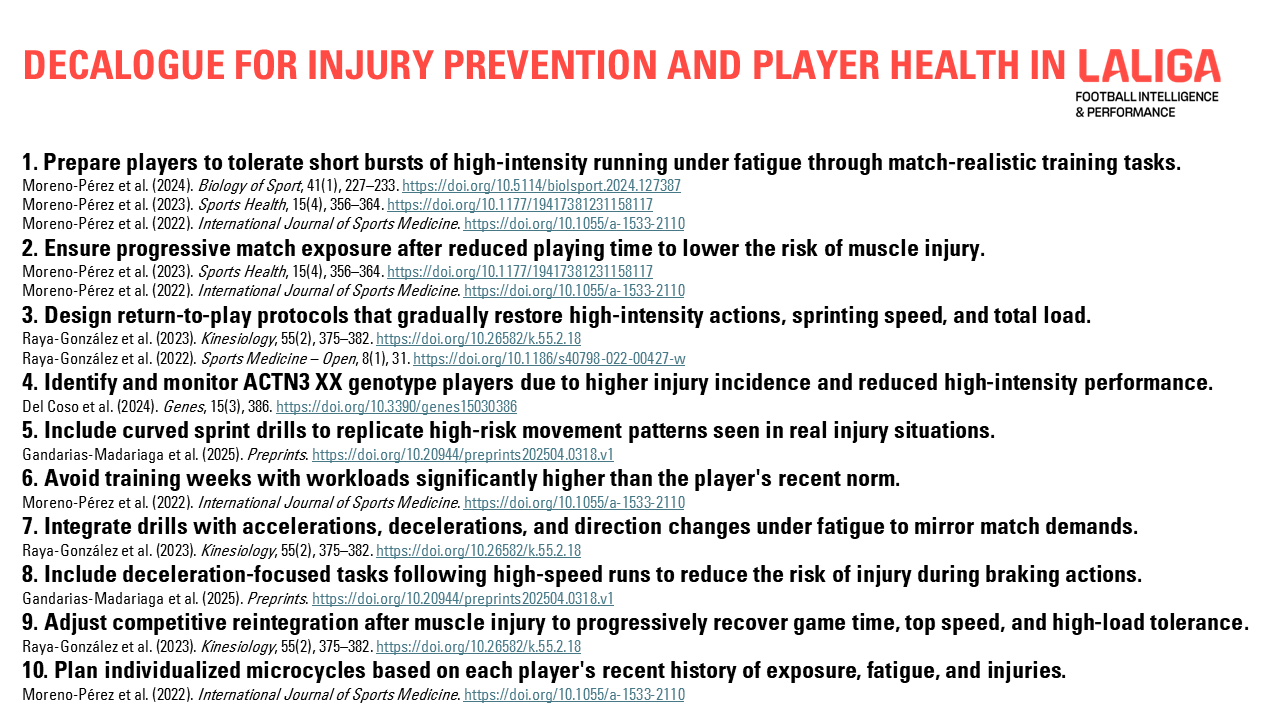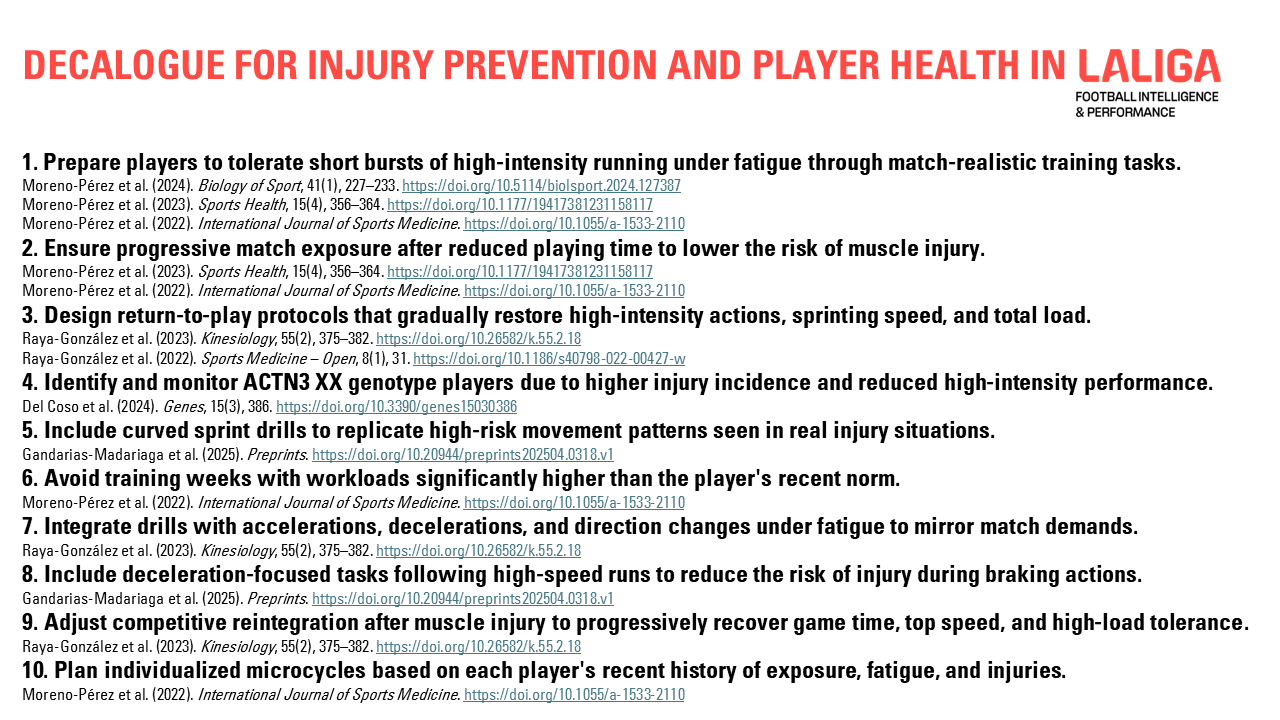
10 Abr 10 Practical Lessons from LALIGA Science: How to Better Prevent Injuries in Professional Football

Introduction The growing complexity and intensity of elite football demand increasingly refined strategies to reduce injuries and optimize player availability. However, the technical and rigorous nature of international scientific publications often creates a barrier for many fitness coaches to access and apply this valuable knowledge. At LALIGA’s Football Intelligence & Performance Area, in collaboration with several leading universities, we have developed a line of applied research with a clear goal: generate high-quality scientific evidence that is directly useful to professional football teams.
This post summarizes the most relevant conclusions from eight peer-reviewed scientific studies, translating them into a clear and accessible language for fitness coaches. We focus on concrete, evidence-based recommendations that can improve day-to-day planning, load management, and return-to-play strategies.
You will also find a downloadable image of the «Decalogue for Injury Prevention and Player Health in LALIGA», a synthesis of these key findings.
1. Short bursts of high-speed running increase injury risk if players are not prepared In matches, hamstring injuries are often preceded by 5 minutes with unusually high distances covered above 21 km/h. In fact, players who exceeded 30 m at these speeds within 5 minutes were up to 7 times more likely to get injured (Moreno-Pérez et al., 2024. Biology of Sport, 41(1), 227–233. https://doi.org/10.5114/biolsport.2024.127387). Coaches should replicate this type of short, intense effort under fatigue during training to better prepare players for real-game scenarios (Moreno-Pérez et al., 2022. International Journal of Sports Medicine. https://doi.org/10.1055/a-1533-2110).
2. Less match time in the previous two weeks = more injuries Players who had played fewer minutes in the one or two matches prior to their injury had significantly higher injury rates, especially hamstring-related (Moreno-Pérez et al., 2023. Sports Health, 15(4), 356–364. https://doi.org/10.1177/19417381231158117).
3. Weeks with unusually high training load are a red flag Muscle injuries often came after weeks with significantly higher training volume (in minutes) and perceived exertion (sRPE), especially when combined with high match intensity (Moreno-Pérez et al., 2022. International Journal of Sports Medicine. https://doi.org/10.1055/a-1533-2110).
4. After a muscle injury, recovery of physical performance takes time Players returning from moderate or severe hamstring injuries took several matches to regain their pre-injury top speed, number of sprints, and high-intensity actions (Raya-González et al., 2023. Kinesiology, 55(2), 375–382. https://doi.org/10.26582/k.55.2.18).
5. Some players are genetically more prone to injury Players with the ACTN3 XX genotype had lower high-speed running metrics and up to twice the injury incidence during matches compared to RR players (Del Coso et al., 2024. Genes, 15(3), 386. https://doi.org/10.3390/genes15030386).
6. Curved sprinting is more risky than you think More than 50% of sprint-type hamstring injuries in LALIGA happened during curved sprints, not straight-line (Gandarias-Madariaga et al., 2025. Preprints. https://doi.org/10.20944/preprints202504.0318.v1). Yet most sprint drills in training are linear. Integrating curved sprint work could help prevent real-match injury patterns.
7. Decelerations after high-speed runs are a critical injury moment A large portion of injuries occurred not during the sprint itself, but in the deceleration phase. Coaches should pay close attention to players braking after accelerations, especially under fatigue or during high-cognitive load actions like duels (Gandarias-Madariaga et al., 2025. Preprints. https://doi.org/10.20944/preprints202504.0318.v1).
8. Match injury risk increases in the last 15 minutes Many injuries occurred in the final 15 minutes of either half, a phase of the game with accumulated fatigue and less tactical control (Moreno-Pérez et al., 2024. Biology of Sport, 41(1), 227–233. https://doi.org/10.5114/biolsport.2024.127387; Raya-González et al., 2023. Kinesiology, 55(2), 375–382. https://doi.org/10.26582/k.55.2.18).
9. Returning players need more than clearance: they need time Even after medical clearance, players took 3 to 4 games to regain key performance metrics like maximum speed and high metabolic load distance (Raya-González et al., 2023. Kinesiology, 55(2), 375–382. https://doi.org/10.26582/k.55.2.18).
10. Load must always be contextualized There is no absolute «dangerous» load. What matters is whether that load is unusual for that player, in that context. A high-speed run, a 75-minute game, or a heavy training week are only risky if they exceed the player’s normal exposure (Moreno-Pérez et al., 2022. International Journal of Sports Medicine. https://doi.org/10.1055/a-1533-2110).
Conclusion: From science to training ground These ten principles, backed by research led by LALIGA’s Football Intelligence & Performance Area, aim to reduce injury risk by aligning science with real football. By understanding what happens just before injuries, how recovery affects performance, and how load interacts with individual history, fitness coaches can make smarter, safer, and more effective decisions.


